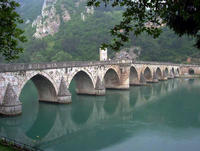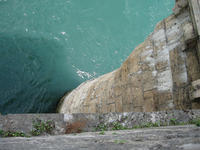You are in: Europe -> Bosnia and Herzegovina -> Mehmed Paša Sokolov... , and traditional search or Image Gallery will yield results of this site only
Mehmed Paša Sokolović Bridge in Višegrad
| Site number: | 1260 |
|
| Type of site: | Cultural | |
| Date: | 16th century | |
| Date of Inscription: | 2007 | |
| Location: | Europe, Bosnia and Herzegovina, Republika Srpska, Sarajevo Macro Region | |
Up to 75 images are shown here. Click on each for more details or on Image Gallery for more images.
| Description: | Built at the end of the 16th century, the Mehmed Paša Sokolović Bridge of Višegrad crosses the Drina River in the east of Bosnia and Herzegovin, the construction of which was ordered by the Grand Vizier Mehmed Paša Sokolović. The design was conceived by the court architect Sinan, and is typical of the apogee of Ottoman monumental architecture and civil engineering. Consisting of 11 masonry arches which span 11 to 15 metres, the bridge includes an access ramp at right angles with four arches on the river’s left bank. Mimar Koca Sinan was one of the classical Ottoman period’s greatest architects and engineers, and a contemporary of the Italian Renaissance, with which his work measures up to. The 179.50m long bridge is a representative masterpiece of his work, encompassing a unique elegance of proportion and monumental nobility; elements that allude to the greatness of this architectural style. --WHMNet paraphrase from the description at WHC Site, where additional information is available. | |
| The Mehmed Paša Sokolović Bridge in Višegrad across the Drina River in Republic of Srpska (Eastern Bosnia and Herzegovina) was built at the end of the 16th century by the Ottoman court architect Sinan on the order of the Grand Vizier Mehmed Paša Sokolović. It is characteristic of the apogee of Ottoman monumental architecture and civil engineering. It numbers 11 masonry arches, with spans of 11 to 15 metres, and an access ramp at right angles with four arches on the left bank of the river. The 179.50m long bridge is a representative masterpiece of Mimar Ḳoca Sinan, one of the greatest architects and engineers of the classical Ottoman period and a contemporary of the Italian Renaissance, with which his work can be compared. The unique elegance of proportion and monumental nobility of the property as a whole bear witness to the greatness of this style of architecture. Three of its 11 arches were destroyed during World War I and five were destroyed during World War II but were subsequently restored. During the Bosnian War the bridge was a place of a brutal killings of a large number of civilians during the Višegrad massacre in 1992. The bridge is the most widely known cause of the book The Bridge on the Drina written by Ivo Andrić, Nobel prize winning author. --Wikipedia. Text is available under the Creative Commons Attribution-ShareAlike License. | ||
| Source: | http://whc.unesco.org/en/list/1260 | |
| Reference: | 1. UNESCO World Heritage Center, Site Page. | |


















